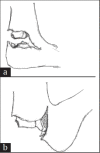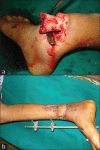Wound coverage considerations for defects of the lower third of the leg
- PMID: 23162228
- PMCID: PMC3495379
- DOI: 10.4103/0970-0358.101299
Wound coverage considerations for defects of the lower third of the leg
Abstract
Anatomical features of the lower third of the leg like subcutaneous bone surrounded by tendons with no muscles, vessels in isolated compartments with little intercommunication between them make the coverage of the wounds in the region a challenging problem. Free flaps continue to be the gold standard for the coverage of lower third leg wounds because of their ability to cover large defects with high success rates and feasibility of using it in acute situations by choosing distant recipient vessels. Reverse flow flaps are more useful for the coverage of the ankle and foot defects than lower third leg defects. The perforators in the lower third leg on which these flaps are based are often damaged during the injury. In medium-sized defects of less than 50 cm(2) size, local transposition flaps, perforator flaps, or propeller flaps can be used. Preoperative identification by the Doppler is essential before embarking on these flaps. Of the muscle flaps, the peroneus brevis flap can be used in selected cases with small defects. In spite of all recent developments, cross-leg flaps continue to remain as a useful technique. In rare occasions when other flaps are not possible or when other options fail it can be a life boat. In the author's practice free flaps continue to be the first choice for coverage of wounds in the lower third leg with gracilis muscle flap for small and medium defects, latissimus dorsi muscle flap for large defects and anterolateral thigh flap when a skin flap is preferred.
Keywords: Free flaps; lower leg defects; perforator flaps.
Conflict of interest statement
Figures







References
-
- Gupta A, Shatford RA, Wolff TW, Tsai TM, Scheker LR, Vevin LS. Treatment of the severely injured upper extremity. J Bone Joint Surg. 1999;81:1628–51. - PubMed
-
- Sabapathy SR. Debridement – preparing the wound bed for cover. In: Sarabahi S, Tiwari VK, editors. Principles and Practice of Wound Care. New Delhi: Jaypee Pubishers; 2012. pp. 68–79.
-
- Godina M. A thesis on the management of injuries to the lower extremity. Ljubljana: PresernovaDruzba; 1991.
-
- Godina M. Preferential use of end-to-side arterial anastomoses in free flap transfers. Plast Reconstr Surg. 1979;64:673–82. - PubMed
-
- Lutz BS, Wei FC, Machens HG, Rhode U, Berger A. Indications and limitations of angiography before free flap transplantation to the distal lower leg after trauma: Prospective study in 36 patients. J Reconstr Microsurg. 2000;16:187–91. - PubMed
LinkOut - more resources
Full Text Sources

